Fractions and Decimals
BACK TO Curriculum Resource Guides
Curriculum Resource Guide - Mathematics Content: Fractions and Decimals
| The Curriculum Resource Guides describe how to teach the content to students with the most significant cognitive disabilities. |
|---|
| Used in conjunction with the Content Modules that describe the content (what is being taught) in general education they provide teachers with the necessary background knowledge to prepare students for the NCSC alternate assessment. |
| The Curriculum Resource Guides offer examples of how the content is taught in general education, ideas for real life use, examples of universal design for learning, and ways to promote college and career readiness. |
Questions about:
- Ratio and Proportions
- Ratio and Proportions Teaching Activities
- Ratio and Proportions and Common Core Connectors
- Real World Ratio and Proportion Activities
- Promoting College and Career Readiness through Ratio and Proportions
- Making Ratio and Proportions Accessible to ALL Students
What are "fractions" and how are they taught in general education settings?
The essential knowledge in this content area
The concept of a fraction refers to equal parts of a whole region or set. Students are expected to represent fractions as equal parts of the whole. Initially this should be taught by working with "fair shares" of an item (e.g., There are 4 of us and we want to divide our apple into 4 equal parts so that we each have a fair share). Next students should only work with fractions using region models (square, etc.), and linear models are preferred. Then the symbolic representation can be taught. [1]
Students should know that fractions parts must be equal in size.
Students need to learn to compare fractions:
- When the fraction is divided into more parts the size of the fractional parts gets smaller.
- Place fractions on a number line:
- Divide spaces between each whole number into equal parts (i.e., 5 segments between 0 and 1)
- Students identify that the distance between 0 and the first 3 segments is 3/5.
- Can be determined by using visual models.
Students should be provided many opportunities to practice making models of equivalent fractions to ensure understanding. One idea is to use fraction strips or bars to demonstrate equivalencies.[3]
Add or subtract fractions with like denominators
- Make sure students understand that if the denominators are the same, they just add or subtract the numerators (or numbers on top) and the denominator stays the same.[4]
Add or subtract fractions with unlike denominators
- First, teach students using fraction strips to help them visualize the concept of adding fractions with unlike denominators.[5]
- Then, teach students to find common denominators and then add or subtract the fractions. This can be done by multiplying the denominators or by determining the least common denominator (LCD). The LCD can be found by determining the multiples of each denominator and finding the smallest number (>1) they have in common.
Write fraction as decimal
- Students learn to divide the numerator by the denominator to change a fraction to a decimal.
Multiply and divide fractions
- Students can learn these concepts first by using models. Students need to understand that
 is asking for 4 sets of
is asking for 4 sets of  . First students can draw or make several wholes divided into thirds. Then students can circle 4 sets of
. First students can draw or make several wholes divided into thirds. Then students can circle 4 sets of  .
.
In this model 2 wholes were circled and  of another whole were circled. Thus:
of another whole were circled. Thus:

This could also be represented on a number line with each whole divided into thirds.
- Once students understand the underlying concept of multiplying fractions, they can begin using symbols and strategies for solving multiplication problems symbolically. For multiplication students learn to multiply the numerators, then denominators, and then find the simplest form of the fraction.

- Students need to understand the division of fractions. For example, the problem
 is asking, "How many
is asking, "How many  are in 2?" Below is a visual model to support students' understanding. First, 2 wholes are drawn. Then, the 2 wholes are divided into thirds.
are in 2?" Below is a visual model to support students' understanding. First, 2 wholes are drawn. Then, the 2 wholes are divided into thirds.
There are 3 groups of 2/3. Therefore  .
.
- Once students understand the underlying concept of dividing fractions, they can begin using symbols and strategies for solving division problems symbolically. For division students learn to multiply by the reciprocal of the divisor and then find the simplest form of the fraction.
- The reciprocal of a fraction is the inverse (i.e., the reciprocal of
 )
)
- The reciprocal of a fraction is the inverse (i.e., the reciprocal of
Common misunderstandings in this content area
Students understand whole numbers and apply this understanding to fractions. Therefore, when they see 1/6 and 1/5 they may assume that 1/6 is larger because 6 is greater than 5. Students have difficulty understanding the relationship between the numerator and the denominator and instead may comprehend them as two separate whole numbers. This can result in students adding across fractions (i.e., numerator plus numerator over denominator plus denominator). Students also might have difficulty understanding that all 1/2s are not equal. For example 1/2 of a large pizza is larger than 1/2 of a medium pizza. This relates to understanding the 1/2 always relates to the specific "whole" that is being referred to by the fraction.[7]
Prior Knowledge/skills needed (can be taught concurrently)
- Number sense with whole numbers
- Addition, subtraction, multiplication and division
- Understanding greater than/less than
- Sequencing numbers
What are "decimals" and how are they taught in general education settings?
The essential knowledge in this content area
Students need to understand that the numerals that come after the "dot" in a number represent an amount less than one. It will be helpful to use a place value chart to teach decimal labels.
| Hundreds | Tens | Ones | Decimal | Tenths | Hundredths |
| ● | 4 | 5 |
In this example the decimal is .45. It could be represented by a fraction as 45/100 or 4/10 +5/100. Students would name this fraction/decimal as forty-five hundredths.
Similar to a fraction, a decimal represents a part of a whole.8 Students should have extensive practice with models to ensure comprehension of the concept.

Students can then learn to order decimals first by using representations, and then numerically. It is important for students to be able to convert decimals to fractions. This will be easier for them to comprehend having used models to represent the concepts.
What are some of the types of activities general educators will use to teach this skill?
Activities from General Education Resources
(CCR & Standards for Mathematical Practice Reference Table)
Fractions
-
 8 Using ten counters, lay them out so that some are red and some are yellow. Tell what fraction of the counters are red and what fraction are yellow.[8]
8 Using ten counters, lay them out so that some are red and some are yellow. Tell what fraction of the counters are red and what fraction are yellow.[8]
-
 2 Have students make a quilt by gluing 16 precut squares of three different colors onto their paper. Now have them describe the number of colors used in fractions (i.e. "Use a fraction to tell me how much of the quilt is purple.").10
2 Have students make a quilt by gluing 16 precut squares of three different colors onto their paper. Now have them describe the number of colors used in fractions (i.e. "Use a fraction to tell me how much of the quilt is purple.").10
-
 4
4 1 To explore equivalent fractions have students fold a circle in half, draw a line on the fold and color one part of the circle. Then take another circle that is the same size and fold it in half; then fold in half again. Draw lines on the folds and this time color two parts of the circle. Then ask the students to describe how the colored portions are the same and how they are different. Last have them write fractions to represent the colored portions.10
1 To explore equivalent fractions have students fold a circle in half, draw a line on the fold and color one part of the circle. Then take another circle that is the same size and fold it in half; then fold in half again. Draw lines on the folds and this time color two parts of the circle. Then ask the students to describe how the colored portions are the same and how they are different. Last have them write fractions to represent the colored portions.10
-
 6
6 4 Students make a healthy fruit snack by following directions that include fractions of a cup in the ingredients list.10
4 Students make a healthy fruit snack by following directions that include fractions of a cup in the ingredients list.10
-
 2
2 4 Students make a bracelet using two different color beads then describe the colors used to make the bracelet in fractions.[9]
4 Students make a bracelet using two different color beads then describe the colors used to make the bracelet in fractions.[9]
-
 4 Give students counters and ask them to demonstrate a fraction and one that is equivalent to it (e.g., 3/4 and 6/8)[10]
4 Give students counters and ask them to demonstrate a fraction and one that is equivalent to it (e.g., 3/4 and 6/8)[10]
-
 5
5 2 Using a number line to 20, have students place counters above all the multiples of 2. Then have them place counters of a different color above all the multiples of 3. Ask them to identify the smallest number that 2 and 3 have in common.12
2 Using a number line to 20, have students place counters above all the multiples of 2. Then have them place counters of a different color above all the multiples of 3. Ask them to identify the smallest number that 2 and 3 have in common.12
-
 2
2 2 Students use grid paper to demonstrate addition of fractions with common denominators. First they trace the perimeter of the total number of squares (denominator), then they use two different colors to represent the two fractions summed, last they count the total number of squares colored and write the answer.12
2 Students use grid paper to demonstrate addition of fractions with common denominators. First they trace the perimeter of the total number of squares (denominator), then they use two different colors to represent the two fractions summed, last they count the total number of squares colored and write the answer.12
-
 4
4 4 Use pennies, dimes, and dollars to demonstrate one-hundredths, tenths, and 1 whole. Write as decimals and fractions.10
4 Use pennies, dimes, and dollars to demonstrate one-hundredths, tenths, and 1 whole. Write as decimals and fractions.10
-
 4
4 2 Use graph paper to model multiplying whole numbers by decimals. Have students color in the decimal and then repeat the number of times it is multiplied. Then count to find the answer.
2 Use graph paper to model multiplying whole numbers by decimals. Have students color in the decimal and then repeat the number of times it is multiplied. Then count to find the answer.
-
 2
2 3 Write several familiar fractions on note cards and several decimals that are close to the fractions but not exactly the same. Have students play a matching game matching the decimals and fractions.
3 Write several familiar fractions on note cards and several decimals that are close to the fractions but not exactly the same. Have students play a matching game matching the decimals and fractions.
-
 5
5 2 Create a decimal number line. Then have students place a list of several decimals in numerical order on the number line.
2 Create a decimal number line. Then have students place a list of several decimals in numerical order on the number line.
Links Across Content Areas
-
 6
6 4 Using measurements to conduct a science experiment.
4 Using measurements to conduct a science experiment.
-
 4
4 3 Reading music to play an instrument.
3 Reading music to play an instrument.
-
 5 Measuring distance between destinations in social studies.
5 Measuring distance between destinations in social studies.
What Connectors to the Common Core Standards Are Addressed in Teaching "Fractions and Decimals"?
Link Core Content Connectors for the Common Core State Standards This guide is not intended to comprehensively cover all of the CCCs related to this topic. For further information on other CCC's related to fractions, see the Instructional Families, Content Modules, and Element Cards/Graduated Understandings.
| Grade Differentiation | Core Content Connectors | Common Core State Standards |
| 3rd grade | 3.SE.1g1 Use =, <, or > to compare 2 fractions with the same numerator or denominator. | 3.NFA.A.3d |
| 3.NO.1l1 Identify the number of highlighted parts (numerator) of a given representation (rectangles and circles). | 3.NF.A.1 | |
| 3.NO.1l2 Identify the total number of parts (denominator) of a given representation (rectangles and circles). | 3.NFA.A.1 | |
| 3.NO.1l3 Identify the fraction that matches the representation (rectangles and circles; halves, fourths, thirds, and eighths). | 3.NF.A.1 | |
| 3.NO.1l4 Identify that a part of a rectangle can be represented as a fraction that has a value between 0 and 1. | 3.NF.A.2a, b | |
| 3.PRF.1f 1 Determine the equivalence between number of minutes and the fraction of the hour (e.g., 30 minutes = ½ hour) . | 3.MD.A.1 | |
| 3.GM.1i1 Partition rectangles into equal parts with equal area. | 3.G.A.2 | |
| 4th grade | 4.SE.1g2 Use =, <, or > to compare 2 fractions (fractions with a denominator or 10 or less). | 4.NF.A.2 |
| 4.SE.1g3 Use =, <, or > to compare 2 decimals (decimals in multiples of .10) | 4.NF.C.7 | |
| 4.SE.1h1 Express whole numbers as fractions. | 3.NF.A.3c | |
| 4.SE.1h2 Identify the equivalent decimal for a fraction. | 4.NF.C.6 | |
| 4.NO.1l6 Locate fractions on a number line. | 3.NF.A.2 | |
| 4.NO.1l7 Order fractions on a number line. | 3.NF.A.2 | |
| 4.NO.1m1 Determine equivalent fractions. | 3.NF.A.3, 4.NF.A.1 | |
| 4.NO.1n1 Select a model of a given fraction (halves, thirds, fourths, sixths, eighths). | 3.NF.A.1 | |
| 4.NO.1n2 Compare up to 2 given fractions that have different denominators. | 4.NF.A.2 | |
| 4.NO.1o1 Match a fraction with a denominator of 10 or 100 as a decimal (5/10 = .5). | 4.NF.C.6 | |
| 4.NO.1o2 Find the equivalent decimal for a given fraction. | 4.NF.C.5 | |
| 4.NO.1p1 Read, write or select decimals to the tenths place. | 4.NF.C.6 | |
| 4.NO.1p2 Read, write or select decimals to the hundredths place. | 4.NF.C.6 | |
| 4.NO.1q1 Compare two decimals to the tenths place with a value of less than 1. | 4.NF.C.7 | |
| 4.NO.1q2 Compare two decimals to the hundredths place with a value of less than 1. | 4.NF.C.7 | |
| 4.NO.2g1 Using a representation, decompose a fraction into multiple copies of a unit fraction (e.g., ¾ = ¼ + ¼ + ¼ ). | 3.NF.A.1, 4.NF.B.3a, b | |
| 4.NO.2h1 Add and subtract fractions with like denominators of (2,3,4, or 8). | 4.NF.B.3a, b | |
| 4.NO.2h2 Add and subtract fractions with like denominators (2,3,4, or 8) using representations . | 4.NF.B.3a, b | |
| 4.NO.2h3 Solve word problems involving addition and subtraction of fractions with like denominators (2, 3, 4, or 8). | 3.NF.A.3d | |
| 5th grade | 5.NO.1b1 Read, write, or select a decimal to the hundredths place | 5.NBT.A.3a |
| 5.NO.1b2 Read, write or select a decimal to the thousandths place. | 5.NBT.A.3a | |
| 5.NO.1b3 Compare two decimals to the thousandths place with a value of less than 1. | 5.NBT.A.3a | |
| 5.NO.1b4 Round decimals to the next whole number. | 5.NBT.A.4 | |
| 5.NO.1b5 Round decimals to the tenths place. | 5.NBT.A.4 | |
| 5.NO.1b6 Round decimals to the hundredths place. | 5.NBT.A.4 | |
| 5.NO.1c1 Rewrite a fraction as a decimal. | 4.NF.C.6 | |
| 5.NO.1c2 Rewrite a decimal as a fraction. | 4.NF.C.6 | |
| 5.NO.2b1 Add and subtract fractions with unlike denominators by replacing fractions with equivalent fractions (identical denominators). | 5.NF.A.1 | |
| 5.NO.2b2 Add or subtract fractions with unlike denominators. | 5.NF.A.1 | |
| 5.NO.2b3 Multiply or divide fractions. | 5.NF.B.4 | |
| 5.NO.2c1 Solve 1 step problems using decimals. | 5.NBT.B.7 | |
| 5.NO.2c2 Solve word problems involving the addition, subtraction, multiplication or division of fractions. | 5.NF.A.2 | |
| 6th grade | 6.NO.1f4 Find a missing value (representations, whole numbers, common fractions, decimals to hundredths place, percent) for a given ratio. | 6.RP.A.3a |
| 6.NO.2c3 Solve one step, addition, subtraction, multiplcation, or division problems with fractions or decimals. | 6.NS.A.1 | |
| 6.NO.2c4 Solve word problems involving the addition, subtraction, multiplication or division of fractions. | 5.NF.B.7c | |
| 7th grade | 7.NO.1h1 Identify an equivalent fraction, decimal and percent when given one of the three numbers. | 6.RP.A.3d |
| 8th grade | 8.NO.2i3 Solve one step addition, subtraction, multiplication, division problems with fractions, decimals, and positive/negative numbers. | 7.NS.A.1d |
| 8.NO.2i4 Solve two step addition, subtraction, multiplication, and division problems with fractions, decimals, or positive/negative numbers. | 7.NS.A.1d | |
| 9-12 | N/A |
| Performance Examples and Essential Understandings for Priority CCCs | |||
| Grade 3 | |||
| CCC | Performance Example | Essential Understandings: Concrete Understandings and Representations | |
| Geometry: 3.GM.1i1 Partition rectangles into equal parts with equal area.
(3.G.A.2) |
|
Concrete Understandings:
|
Representation:
|
| Numbers: 3.NO.1l3 Identify the fraction that matches the representation (rectangles and circles; halves, fourths, thirds, and eighths).
(3.NF.A.1) |
Student selects fraction to represent the picture.
"Choose the fraction that tells how much of the square is colored in." |
Concrete Understandings:
|
Representation:
|
| Symbols: 3.SE.1g1 Use =, <, or > to compare 2 fractions with the same numerator or denominator.
(3.NF.A.3d) |
Student selects correct symbol to compare two fractions.
You are going to compare fractions using these symbols. This fraction is 2/5. This fraction is 4/5. Choose the symbol that shows your answer. Provide ("=", ">", and "<"). Is 2/5 greater than, less than, or equal to 4/5.
|
Concrete Understandings:
|
Representation:
|
| Grade 4 | |||
| CCC | Performance Example | Essential Understandings: Concrete Understandings and Representations | |
| Symbols 4.SE.1g2 Use =, <, or > to compare 2 fractions (fractions with a denominator of 10 or less).
(4.NF.A.2) |
Student selects symbol to compare two numbers.
Choose the symbol that shows whether 1/3 is less than, equal to or greater than 2/6.
Choose the symbol that shows whether 5/8 is less than equal to or greater than 2/4.
|
Concrete Understandings:
|
Representation:
|
| Numbers: 4.NO.1m1: Determine equivalent fractions. (3.NF.3, 4.NF.A.1) | Given a fraction, student selects equivalent fraction.
This fraction is two-thirds. Show me the fraction that is equal to two-thirds.
|
Concrete Understandings:
|
Representation:
|
| Numbers: 4.NO.1n1: Select a model of a given fraction (halves, thirds, fourths, sixths, eighths). (3.NF.A.1) | Student selects picture to represent fraction.
"Show me the rectangle that shows 5/6." |
Concrete Understandings:
|
Representation:
|
| Grade 5 | |||
| CCC | Performance Example | Essential Understandings: Concrete Understandings and Representations | |
| Numbers: 5.NO.1b1: Read, write, and select a decimal to the hundredths place (5.NBT.A.3a) | "I want you to find a number that has a digit in the thousandths place. A digit is a single symbol, 0-9. Which of these numbers has a digit in the thousandths place?
45.72 4572 4.572 |
Concrete Understandings:
|
Representation:
|
| Numbers: 5.NO.1c1: Rewrite a fraction as a decimal. (4.NF.C.6) | Student rewrites a fraction as a decimal.
Rewrite the fraction 35/100 as a decimal.
|
Concrete Understandings:
|
Representation:
|
| Numbers: 5.NO.2c2: Solve word problems involving the addition, subtraction, multiplication, or division of fractions. (5.NF.A.2) | Given a word problem (teacher may read aloud), student shows work and solves the equation.
Jesse and her mother baked 24 cookies. They ate ¼ of the cookies. How many cookies did they eat? Show your work as you solve the problem. |
Concrete Understandings:
|
Representation:
|
| Grade 6 | |||
| CCC | Performance Example | Essential Understandings: Concrete Understandings and Representations | |
| Numbers: 6.NO.2c3: Solve one step addition, subtraction, multiplication, or division problems with fractions or decimals. (6.NS.A.1) | Present each problem one at a time and read it to the student. After reading it say "Solve this problem." Wait for the student to solve the problem, then remove the problem, present the next one, read it, and say "Solve this problem." Continue until the student has completed all four problems.
|
Concrete Understandings:
|
Representation:
|
| Grade 7: NONE | |||
| Grade 8 | |||
| CCC | Performance Example | Essential Understandings: Concrete Understandings and Representations | |
| Numbers: 8.NO.2i4: Solve two step addition, subtraction, multiplication, and division problems with fractions, decimals, or positive/negative numbers. (7.NS.A.1d) |
Say "Now you are going to multiply and divide positive and negative numbers." Show the following problems (one at a time). For each problem presented say: "Solve this problem. Make sure to include the positive or negative sign in your answer." Then read the problem to the student. When the first problem is finished, then do the same for the second, third, and fourth problems.
|
Concrete Understandings:
|
Representation:
|
What are Some Additional Activities That Can Promote Use of this Academic Concept in Real World Contexts?
-
 5
5 4 Measuring out fractions of ingredients for cooking.
4 Measuring out fractions of ingredients for cooking.
-
 6
6 2 Using a ruler to measure out fractions of a foot and inch to cut wood to make a birdhouse.
2 Using a ruler to measure out fractions of a foot and inch to cut wood to make a birdhouse.
-
 4
4 4 Students can learn to sort items using the Dewey decimal system in the library.10
4 Students can learn to sort items using the Dewey decimal system in the library.10
-
 2
2 4 Working as a cashier and counting money to make change.
4 Working as a cashier and counting money to make change.
-
 4
4 3 Calculating batting averages for sports team.
3 Calculating batting averages for sports team.
-
 2
2 4 Balancing a checkbook
4 Balancing a checkbook
-
 6
6 4 Measuring out medications
4 Measuring out medications
-
 1
1 3 Calculating a cost of an item in sales promotion (1/2 off sale)
3 Calculating a cost of an item in sales promotion (1/2 off sale)
-
 6
6 4 Measuring someone's height in a doctor's office.
4 Measuring someone's height in a doctor's office.
-
 5
5 4 Cutting hair (customer wants 2 and ½ inches cut)
4 Cutting hair (customer wants 2 and ½ inches cut)
How Can I Further Promote College and Career Readiness when Teaching "Fractions and Decimals"?
Ideas for Promoting Career/ College Ready Outcomes
Communicative competence Students will increase their vocabulary to include concepts related to "fractions and decimals." In addition, they will be learning concepts such as: "half", "whole", "more", "less", "almost," "greater than," "less than," and "equal to." Fluency in reading, writing, and math Students will have an opportunity to increase their numeracy and sight word fluency while participating in problem solving related to "fractions and decimals," such as number recognition, counting, one-to-one correspondence, comparing quantities, and reading concepts that include the use and understanding of descriptors related to size. Age appropriate social skills Students will engage in peer groups to solve problems related to "fractions and decimals" that will provide practice on increasing reciprocal communication and age appropriate social interactions. For example, students might work together with their peers to measure out ingredients for a science experiment or cooking activity. Independent work behaviors By solving real life problems related to "fractions and decimals" students will improve work behaviors that could lead to employment, such as assisting in the library, measuring in construction, and preparing food in a kitchen. When providing opportunities for real life problems leave some materials out and prompt/teach the students to determine who they should ask and what they should ask for to be able to solve the problem. Skills in accessing support systems At times, students will need to ask for assistance to complete activities related to "fractions and decimals" which will give them practice in accessing supports. Students will gain practice asking for tools such as talking calculators, a digital tape measure, or measuring cups. They can ask a peer to complete the physical movements of the tasks they are not able to do themselves. Be sure to teach students to ask versus having items or supports automatically given to them.
How Do I Make Instruction on "Fractions and Decimals" Accessible to ALL the Students I Teach?
Teach Prerequisites and Basic Numeracy Skills Concurrently: Remember that students can continue to learn basic numeracy skills in the context of this grade level content.
Basic numeracy skills that can be worked on as a part of a lesson relating to fractions and decimals:
- number identification
- more and less
- one to one correspondence
- symbol identification

Incorporate UDL: Universal Design of Learning When Teaching Fractions and Decimals
| Visual Impairment or Deaf/Blind | Physical impairment:
Little/no hand use |
Lacks basic numeracy concepts | Motivational/attention issues | |
| Representation | Use a talking calculator when solving equations or converting fractions to decimals and vice versa; use objects to represent fractions and decimals (e.g., Cuisenaire rods®); use raised lines to represent portions of the whole object. Create fraction models using cardboard (rectangular and circular) with textured surfaces to indicate parts. Use items that are velcroed together to represent the whole and have the student separate the whole into parts. Another option would be to use snap cubes. | Count the parts of fractions or decimals using a step by step process which progresses through numbers; student scans an array of possible options and uses a switch to select the number to identify the numerator; use computer representation of fractions that can be manipulated with switch; place fraction representations on a slant board or eye gaze board; create a grid on a large surface on the floor that the student can walk over or ride over in wheelchair. | Use fraction and decimal manipulatives that can be separated and placed on a number line. Use real world objects that have been partitioned to represent fractions (e.g., graham cracker, candy bar). Students can use one to one correspondence to match equal number of parts on representation of fraction or decimals. Color code equations and corresponding parts of calculator to support students correctly entering numerals and equations. | Find fractions of motivating objects (e.g., pizza, coloring markers in a box, pieces of a Lego set). Incorporate technology including computer representations, videos, animations, and talking calculators. Use token economy system that embeds fractions (e.g., "You earned ¼ of your Lego piece, you have ¾ left and then you get Lego time.) |
| Expression | Student states answer or scans raised numbers to select correct answer; use voice output devices for student to select the correct answer; teach tangible symbols that mean fraction and decimal. | Student scans and selects number that represents numerator or denominator; uses a switch to indicate correct answers; use an eye gaze board to select answer; use a blink response to count parts or select answer; phrase questions so that they require a "yes/no" response, these can easily be answered using an eye gaze, head turn, two switches, etc.; count parts of fractions out loud having student move in some voluntary way (e.g., nod head, tap hand, tap foot) to count along. | Student selects numerals and fractions versus writing them; selection of correct answer is done after a model; student points to each part of a fraction or decimal while teacher or peer counts aloud; student answers "yes/no" questions regarding fractions or decimals after parts have been counted aloud (e.g., 1,2,3,4. There are 4 colored parts. Is this the number we write as the numerator?); matches the parts of a fraction to the correct number (matches 4 to 4). | Have students express fractions using high interest manipulatives (e.g., Legos, food items such as chocolate bar or graham crackers, stickers of favorite characters, or jewelry beads). Provide students with response options that keep them engaged (e.g., options provided on AAC device, tablet, response cards, or interactive whiteboard.) |
| Engagement | Teach students to use their hands to scan the raised or textured parts of each whole item; use textures or concrete objects to represent fractions; start with simple, clearly defined fractions; use items that are familiar and reinforcing to students. | Use bright colors to call attention to numerators; use a computer with AT where the student can click to answer; use figures that are large enough to accommodate the movements that the student is able to make; pair student with another student without a physical impairment and have them work together to create fraction and decimal representations. | Student uses talking calculator and AAC device or other response board, limit fractions and decimals to numerals less than 10, use bright colors to represent fractions and numerals, use familiar objects to represent fractions. | Use visuals and concrete representations and technology. Provide frequent opportunities for responding. Use token economy system that embeds fractions ("you earned ¼ of your Lego piece, you have ¾ left and then you get Lego time."). |
CCR & Standards for Mathematical Practice Table
- ↑ Hake, S., Saxon, J. H. (2004). Saxon math 5/4. Norman, OK: Saxon Publishers, p. 96. TERC (Firm), Pearson Education, Inc., & Scott, Foresman and Company.(2004). Investigations in number, data, and space. Glenview, IL: Scott Foresman, p. 10-11.
- ↑ Hake, S., Saxon, J. H. (2004). Saxon math 5/4. Norman, OK: Saxon Publishers, p. 96.
- ↑ Maletsky, E. M., & Andrews, A. G. (2004). Harcourt math. Orlando, FL: Harcourt School Publishers, p. 326. Greenes, C. E. (2005). Houghton Mifflin math: Grade 4. Boston, MA: Houghton Mifflin Co., p. 510
- ↑ Greenes, C. E. (2005). Houghton Mifflin math: Grade 4. Boston, MA: Houghton Mifflin Co., p. 528.
- ↑ Help with Fractions. (2012) Retrieved from http://www.helpwithfractions.com/adding-fractions-different-denominators.html
- ↑ Free Math Help. (2013). Retrieved from http://www.freemathhelp.com/adding-subtracting-rational-functions.html
- ↑ TERC (Firm), Pearson Education, Inc., & Scott, Foresman and Company.(2004). Investigations in number, data, and space. Glenview, IL: Scott Foresman, p. 93, 109.
- ↑ Greenes, C. E. (2005). Houghton Mifflin math: Grade 4. Boston, MA: Houghton Mifflin Co., p. 500, 552, 563.
- ↑ Maletsky, E. M., & Andrews, A. G. (2004). Harcourt math. Orlando, FL: Harcourt School Publishers, p. 348.
- ↑ Glencoe/McGraw-Hill. (2009). Math connects: Concepts, skills and problem solving. Columbus, OH: Glencoe/McGraw-Hill, p. 202, 216, 256.


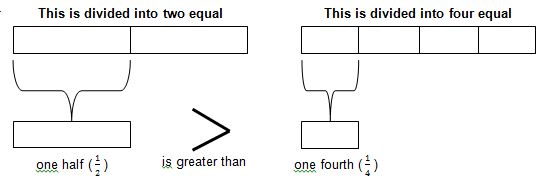

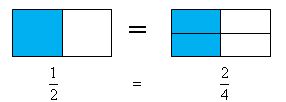
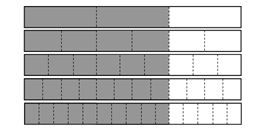
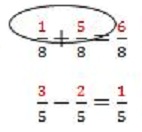
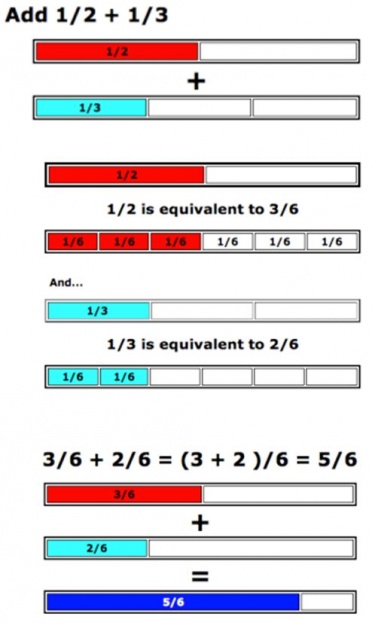
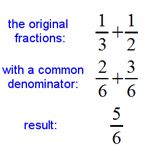


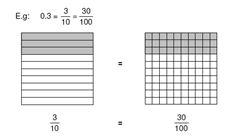






 ____
____

 ____
____

 _____________
_____________
 _____________
_____________
 ______________
______________
 ______________
______________
 _________
_________
 _________
_________
 _________
_________
 _________
_________